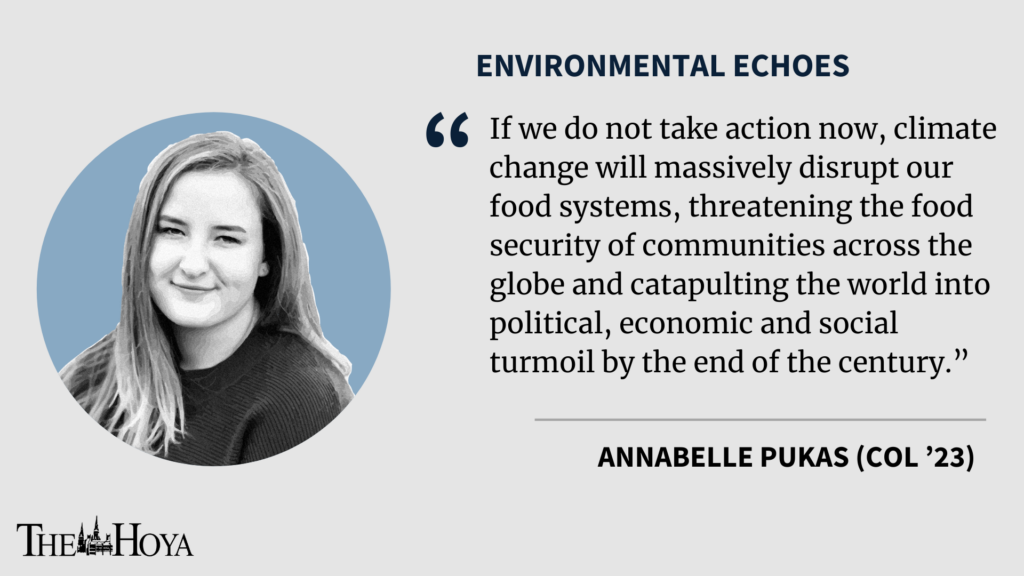The media often portrays climate change as an inescapable cycle of natural disasters. Intense heat waves and forest fires are followed by hurricanes, heavy rain and mudslides, which in turn are followed by freezing winters and record snowfall. Yet the true cost of a changing climate hits a bit closer to home, specifically within our kitchens.
If we do not take action now, climate change will massively disrupt our food systems, threatening the food security of communities across the globe and catapulting the world into political, economic and social turmoil by the end of the century.
The world’s 7.8 billion inhabitants already struggle to secure a healthy and consistent food supply; 821 million people are undernourished, 151 million children under age 5 are stunted because of food insecurity and 613 million women and girls suffer from iron deficiency. A rapidly increasing population, coupled with a warming climate, means even more people will become reliant on a diminishing food supply.
In the absence of significant emission reduction, most of the glaciers that provide water to Asia’s most abundant agricultural lands will melt by the end of our lifetimes, which would send roughly 800 million people on a path toward starvation. At the same time, desertification will overtake the Middle East and southern Europe, leaving the region with conditions similar to the Sahara and completely inhospitable to agriculture. In the United States, much of the southwest will once again endure Dust Bowl conditions, except this drought will likely last 30 to 35 years. If greenhouse gas emissions continue on their current path, this megadrought has an 80 percent chance of occurring between 2050 and 2099.
Further, following our current emission trajectory, the production of staple cereal crops is predicted to fall 40% by the end of the century because of less conducive growing conditions. Historically, when the production of staple crops waned, countries with insufficient yields were able to turn to the global trade market and purchase goods from another breadbasket region. However, experts from the Intergovernmental Panel on Climate Change predict multi-breadbasket failure is imminent, and countries will have no choice but to endure food shortages.
Not only will food be in short supply, but it will also be less nutritious. For example, wheat grown at 546 to 586 parts per million of carbon dioxide has 5.9 to 12.7% less protein, 3.7 to 6.5% less zinc and 5.2 to 7.5% less iron. Lower nutritional quality will further increase the burden placed on the already overstretched food market because people will need to consume more food to achieve a comparable nutritional intake.
While global food shortages are bound to affect everyone, food insecurity will have the greatest impact on lower-income individuals and communities. Cereal goods will be up to 29% more expensive by 2050 — a price increase that will put an estimated 183 million more people at risk of hunger.
The agricultural sector is paving the way to its own demise; 21 to 37% of total greenhouse gas emissions are attributable to our food system, and 25 to 30% of all the food produced goes to waste. These rates are utterly unsustainable. Governments and individuals alike must recognize the growing risks of global food insecurity and begin to think more critically about the climate implications of food consumption.
One of the most impactful ways to eat more sustainably is to reduce beef consumption. Nearly 60% of global agricultural land is used to produce beef, yet it only accounts for 2% of the calories humans consume. If everyone cut beef from their diets, land areas equal to the size of the United States, Canada and China combined would be free to use for more sustainable agriculture, like plants or lab-grown meat. For each kilogram of beef not produced, greenhouse gas emissions equivalent to a round trip trans-Atlantic flight are prevented from entering the atmosphere.
Additionally, the world must address its food waste problem. As food decays in landfills, it undergoes an anaerobic process that produces methane, a greenhouse gas 25 times more harmful than carbon dioxide. If food waste was its own country, it would be the third-largest country in the world by total emissions. Both governments and individuals must invest in food waste reduction, whether through composting, enacting policies that prevent grocery stores from throwing away edible food or simply buying imperfect and less attractive food items while shopping.
On campus, students have an array of opportunities to eat more consciously. The Leo J. O’Donovan Dining Hall typically offers over 2,100 vegetarian or vegan meals weekly, and even choosing these options a few times a week would have a massive impact on food-related emissions. While approximately 90% of all waste from Leo’s is composted, students who cook their own meals have opportunities to responsibly dispose of their food waste through programs such as Compost Cab, a compost pickup service located in the D.C.-Maryland-Virginia area, or Washington, D.C. food waste drop-offs.
Ultimately, our current path has our world heading toward a food crisis of unparalleled gravity. But with conscious food consumption and disposal, we can mitigate the crisis, avoid the most dire consequences and eat healthier too.
Annabelle Pukas is a sophomore in the College. Environmental Echoes appears online every other Friday.









